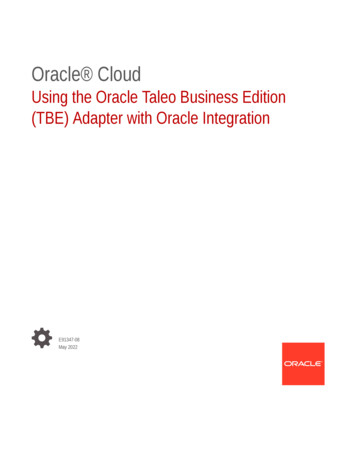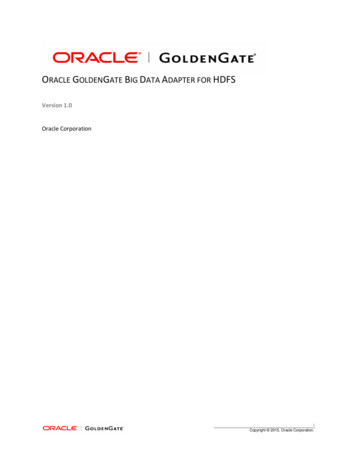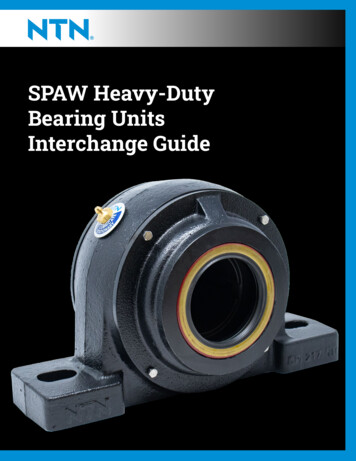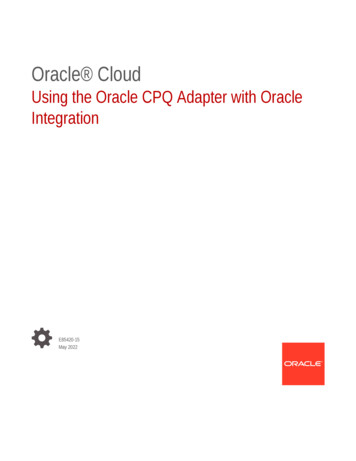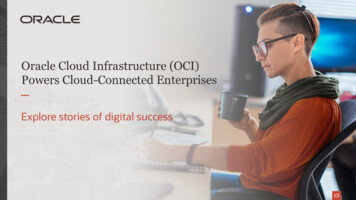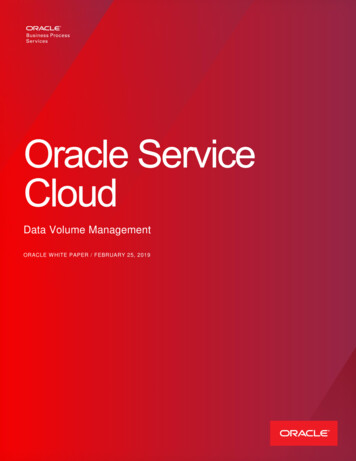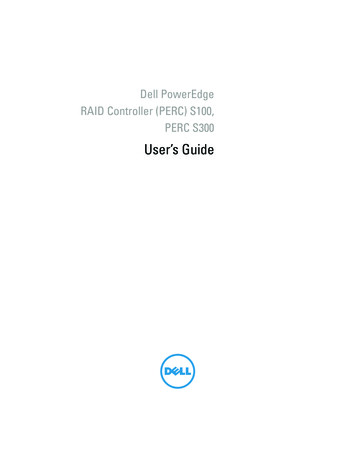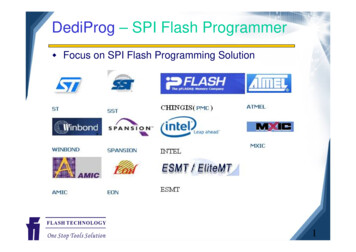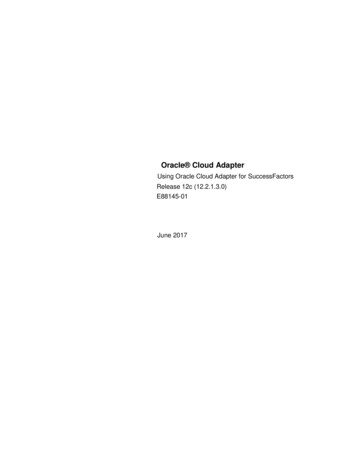
Transcription
Oracle Cloud AdapterUsing Oracle Cloud Adapter for SuccessFactorsRelease 12c (12.2.1.3.0)E88145-01June 2017
Oracle Fusion Middleware Using Oracle Cloud Adapter for SuccessFactors, Release12c (12.2.1.3.0)E88145-01Copyright 2017 Oracle and/or its affiliates. All rights reserved.Primary Author: Ashish JoyContributors: Amrita Chauhan, Susheel Patwal, Himanshu Grover and Shalindra Singh.This software and related documentation are provided under a license agreement containing restrictions on use anddisclosure and are protected by intellectual property laws. Except as expressly permitted in your license agreement orallowed by law, you may not use, copy, reproduce, translate, broadcast, modify, license, transmit, distribute, exhibit,perform, publish, or display any part, in any form, or by any means. Reverse engineering, disassembly, or decompilation ofthis software, unless required by law for interoperability, is prohibited.The information contained herein is subject to change without notice and is not warranted to be error-free. If you find anyerrors, please report them to us in writing.If this software or related documentation is delivered to the U.S. Government or anyone licensing it on behalf of the U.S.Government, the following notice is applicable:U.S. GOVERNMENT RIGHTS Programs, software, databases, and related documentation and technical data delivered toU.S. Government customers are "commercial computer software" or "commercial technical data" pursuant to the applicableFederal Acquisition Regulation and agency-specific supplemental regulations. As such, the use, duplication, disclosure,modification, and adaptation shall be subject to the restrictions and license terms set forth in the applicable Governmentcontract, and, to the extent applicable by the terms of the Government contract, the additional rights set forth in FAR52.227-19, Commercial Computer Software License (December 2007). Oracle USA, Inc., 500 Oracle Parkway, RedwoodCity, CA 94065.This software is developed for general use in a variety of information management applications. It is not developed orintended for use in any inherently dangerous applications, including applications which may create a risk of personal injury.If you use this software in dangerous applications, then you shall be responsible to take all appropriate fail-safe, backup,redundancy, and other measures to ensure the safe use of this software. Oracle Corporation and its affiliates disclaim anyliability for any damages caused by use of this software in dangerous applications.Oracle is a registered trademark of Oracle Corporation and/or its affiliates. Other names may be trademarks of theirrespective owners.This software and documentation may provide access to or information on content, products, and services from third parties.Oracle Corporation and its affiliates are not responsible for and expressly disclaim all warranties of any kind with respect tothird-party content, products, and services. Oracle Corporation and its affiliates will not be responsible for any loss, costs, ordamages incurred due to your access to or use of third-party content, products, or services.
ContentsContents . 1-3Preface . 1-51Introduction to the SuccessFactors Adapter. 1-6Oracle Cloud Adapter for SuccessFactors . 1-6What Application Version Does the SuccessFactors Adapter Support? . 1-6Installing the Cloud Adapters . 1-6Performing Postinstallation Configuration Tasks. 1-7Disabling Hostname Verification. 1-7Obtaining the Authentication Credentials . 1-7Unsupported Features . 1-72Understanding Oracle Cloud Adapter for SuccessFactors Features . 2-8Prerequisites for Creating a Connection . 2-8Designing an Integration with the Adapter Configuration Wizard . 2-8Monitoring Your Application During Runtime . 2-11Uploading an SSL Certificate . 2-11Generating SuccessFactors Certificate. 2-11Importing SuccessFactors Certificate using Keytool . 2-153Designing SOA Composite Applications . 3-18Creating a SOA Composite Application . 3-18Adding an Adapter to a SOA Composite Application as a Reference . 3-18Completing Design of a SOA Composite Application . 3-204Designing Oracle Service Bus Business Services . 4-21Creating an Oracle Service Bus Business Service . 4-21Adding an Adapter to a Business Service as a Reference . 4-21Completing Design of an Oracle Service Bus Business Service . 4-235Configuring Oracle Cloud Adapter for SuccessFactors Properties . 5-24Configuring Basic Information Properties . 5-24What You Can Do from the Basic Info Page . 5-24What You See on the Basic Info Page . 5-25Configuring Oracle Cloud Adapter Connection and CSF key Properties . 5-25Introduction to the SuccessFactors Adapter 1-3
What You Can Do from Oracle Cloud Adapter Connection page . 5-25What You See on the Oracle Cloud Adapter Connection Page. 5-27What You Can Do from the Oracle Cloud Adapter CSF Key Page . 5-27What You See on the Oracle Cloud Adapter CSF Key Page. 5-28Configuring Oracle Cloud Adapter for SuccessFactors Operation Properties . 5-28What You Can Do from the Oracle Cloud Adapter for SuccessFactors Operations Page . 5-28What You See on Oracle Cloud Adapter for SuccessFactors Operations Page . 5-29Reviewing Configuration Values on the Summary Page . 5-30What You Can Do from the Summary Page . 5-30What You See on the Summary Page . 5-316Managing Applications. 6-1Managing the Application in Oracle Enterprise Manager Fusion Middleware Control. 6-1Testing Oracle Service Bus Business Services from Oracle Service Bus Console . 6-17Troubleshooting and Error Handling. 7-1Design Time Troubleshooting and Error Handling . 7-1Test Connection Failure or Wizard Operation Page Does Not Open . 7-1Operation Page Does Not Open Due to Out of Memory Exception . 7-1Run Time Troubleshooting and Error Handling . 7-1Handling SSL Exception . 7-1
PrefaceUsing Oracle Cloud Adapter for SuccessFactors describes how to configure the SuccessFactorsAdapter as a connection in an integration in Oracle SOA Suite.This section consists of the following topics: Audience Related Resources ConventionsAudienceUsing Oracle Cloud Adapter for SuccessFactors User Guide is intended for those who wish to usethe Adapter for integrating Applications with SuccessFactors.Related ResourcesFor more information, see these Oracle resources: Developing SOA Applications with Oracle SOA Suite Administering Oracle SOA Suite and Oracle Business Process Management Suite Administering Oracle Service Bus Understanding Technology AdaptersConventionsThe following text conventions are used in this document:ConventionMeaningoldfaceBoldface type indicates graphical user interface elementsassociated with an action, or terms defined in text or the glossary.italicItalic type indicates book titles, emphasis, or placeholdervariables for which you supply particular values.monospaceMonospace type indicates commands within a paragraph, URLs,code in examples, text that appears on the screen, or text that youenter.Introduction to the SuccessFactors Adapter 1-5
1Introduction to the SuccessFactors AdapterThis section introduces the SuccessFactors Adapter.This chapter consists of the following sections: Oracle Cloud Adapter for SuccessFactors What Application Version Does the SuccessFactors Adapter Support? Installing the Cloud Adapters Performing Postinstallation Configuration Tasks Disabling Hostname Verification Obtaining the Authentication Credentials Unsupported FeaturesOracle Cloud Adapter for SuccessFactorsThe Oracle Cloud Adapter for SuccessFactors enables you to create an integration with SuccessFactorscloud-based human capital management (HCM) software using the Software as a Service (SaaS) model.The Oracle Cloud Adapter for SuccessFactors supports SFAPI (SuccessFactors API) exposed by theSuccessFactors application. Hence, giving exposure to only the business objects that can be accessed viaSFAPI.The Oracle Cloud Adapter for SuccessFactors is one of the many predefined adapters included withOracle SOA Suite. The SuccessFactors adapter is configured as an external reference in Oracle SOASuite.For more information, see Configuring Oracle Cloud Adapter for SuccessFactors Properties.What Application Version Does the SuccessFactors AdapterSupport?The SuccessFactors Adapter is compatible with SuccessFactors version SFAPI 1.2 as well as 1.1.Installing the Cloud AdaptersSee the README.txt available with the patch for instructions on installing the cloud adapters.After you complete the adapter installation, perform the tasks described in Performing PostinstallationConfiguration Tasks.
Note: For information about supported versions and platforms, see the release certification matrixat Supported System Configurations.Performing Postinstallation Configuration TasksYou must perform post-installation configuration tasks after installing the cloud adapters.For information about post-installation configuration tasks, see the Oracle Cloud AdaptersPostinstallation Configuration Guide.Disabling Hostname VerificationBy default, the WebLogic Server Configuration Wizard sets Hostname Verification to be a HostnameVerifier when creating the Oracle SOA Suite and Oracle Service Bus domains. Hostname Verificationmust be set to None for the Oracle Cloud Adapter for SuccessFactors to work. To disable hostnameverification, follow the steps mentioned below:1. Log in to the Oracle WebLogic Server Administration Console.2. Under Domain Environment Servers, double-click the server name.3. Click the SSL tab.4. Under Advanced, update Hostname Verification to None.5. Save the change.Obtaining the Authentication CredentialsObtain the user name and password that are required for creating the Credential Store Framework (CSF)authentication key in Oracle JDeveloper and Oracle Enterprise Manager Fusion Middleware Controlfrom your SOA domain administrator. These credentials are required for most cloud adapters. For theOracle Cloud Adapter for SuccessFactors, the credentials require three properties (companyID,username, and password).Unsupported Features The Oracle Cloud Adapter for SuccessFactors cannot be configured as exposed service. The Oracle Cloud Adapter for SuccessFactors does not support Odata API exposed bySuccessFactors.Introduction to the SuccessFactors Adapter 1-7
2Understanding Oracle Cloud Adapter forSuccessFactors FeaturesThis chapter consists of the following topics: Prerequisites for Creating a Connection Designing an Integration with the Adapter Configuration Wizard Monitoring Your Application During Runtime Uploading an SSL CertificatePrerequisites for Creating a ConnectionYou must satisfy the following prerequisite to create a connection with the SuccessFactors Adapter: Purchase a subscription to SuccessFactors. When you subscribe, you receive a company ID,username, and password. The information is required to configure the connection page of theSuccessFactors Adapter configuration wizard for establishing a connection to theSuccessFactors Application. The Connections page includes an SFAPIWSDL location (WSDLURL). This WSDL location represents your API endpoint, which depends on where yourSuccessFactors instance is located. It can be in one of several data centers. Contact yourSuccessFactors representative if you are unsure of which data center to use.Designing an Integration with the Adapter Configuration WizardYou use the Adapter Configuration Wizard to include the Oracle Cloud Adapter for SuccessFactors in aSOA composite application or an Oracle Service Bus business service.The Adapter Configuration Wizard consists of configuration pages that enable you to select Operationand Object. The required artifacts are generated after the wizard completion. These artifacts are utilizedin runtime to communicate with the SuccessFactors application. You can configure the adapter in theExternal References (outbound).The Basic Info page prompts you to enter a meaningful name and optional description.
The Connection page prompts you to specify the WSDL URL (for /v1/soap12?wsdl), the security policy and authentication keyto use. The authentication key is created by clicking the Add icon to specify the key name,Successfactors companyId, user name, and password. You must also specify these same values inOracle Enterprise Manager Fusion Middleware Control. For instructions, see the Oracle Cloud AdaptersPostinstallation Configuration Guide.The Operations page prompts you to select the Operation Type, Operation Name and the businessobject on which the specified operation is to be applied.Operation type and Operations Supported:Understanding Oracle Cloud Adapter for SuccessFactors Features 2-9
CRUD: Displays the insert, upsert, update, and delete operations that can be performed onSuccessFactors business objects. The Available section contains the business objects whichsupport the selected operation. Select the operation name and the business object on which toperform the operation. SFQL (SuccessFactors Query Language): Enables you to define an SFQL-based query to senda request for querying a particular business object and retrieve the respective object’sinformation. If you select this option, the page is refreshed to display a text box for entering aquery.The Summary page displays your selections for the outbound direction.
The following artifacts are created for each adapter instance in the Applications window in OracleJDeveloper: WSDL file: Only the standard WSDL file type is supported. JCA file: Contains the internal implementation details used by the adapter during runtime. Itcontains the different interaction and connection properties used by the adapter. Whenapplication configuration is complete, you can deploy the application from Oracle JDeveloperto the runtime environment.For information about the details to specify in the fields of the wizard pages, see Configuring Oracle CloudAdapter Connection and CSF Key Properties.Monitoring Your Application During RuntimeThis section describes the design time and runtime aspects of using the Oracle Cloud Adapter forSuccessFactors. You use the runtime part of the adapter for delivering the information generated duringdesign time to the service endpoint. You can monitor your SOA composite application or OracleService Bus business service from Oracle Enterprise Manager Fusion Middleware Control. You canalso test your Oracle Service Bus business service from Oracle Service Bus Console.Uploading an SSL CertificateCertificates are used to validate outbound SSL connections. If you make an SSL connection in whichthe root certificates do not exist in Oracle SOA Servers, an exception is thrown. In that case, you mustupload the appropriate certificates. A certificate enables Oracle SOA to connect with external services.If the external endpoint requires a specific certificate, request the certificate and then upload it intoOracle SOA Servers.Generating SuccessFactors CertificateThe SuccessFactors Client certificate has to be downloaded from the SuccessFactors application userinterface. This certificate has to be imported into the server for successful handshaking withSuccessfactors. The Oracle Cloud Adapter for Successfactors uses two-way SSL when interacting withSuccessfactors and hence requires this certificate. On the WebLogic server, these certificates arerequired to be imported.To download the certificate, use the following procedure:1. Log in to the Successfactors using a valid user companyId, username and password.Understanding Oracle Cloud Adapter for SuccessFactors Features 2-11
2. Click on the lock icon as indicated in the above figure. A small window will pop up. Click on theview certificates as indicated in the figure below.Note: Here, Google Chrome is used for demonstration. Experience may differ if you will be usingother browser or other version of internet explorer. But idea here is to click on security lock tofetch the certificate information.3. After clicking on the view certificates another window pops up providing the details of thecertificate. Open the Certification Path tab and select VeriSign as shown in the screenshot below.The View Certificate button would be enabled, click the same to view certificate details.
4. A new page opens above the existing page, open the Details tab and click on Copy to File button.Understanding Oracle Cloud Adapter for SuccessFactors Features 2-13
5. Now, Certificate Export wizard opens. Click on next button and select Base-64 encoded X.509(.CER) option.
6. Click Next and browse to the location where you want to save the certificate. Provide anappropriate name to the certificate file and save it.7. Double-click and open the Saved certificate.8. Follow the same procedure for remaining two certificate paths.9. Import the downloaded certificates into your application server, and configure your applicationserver to request the client certificate. The application server then checks that the certificates used inthe SSL/TLS handshake matches the one you downloaded.Importing SuccessFactors Certificate using Keytool1. Provide a suitable location on your system to save the certificates authority. You would now addthese certificates to Keystore.2. Make sure that KSS for demo is disabled.3. To disable KSS, go to the WebLogic console (http://url:port/console/).4. Click on Domain Security Advanced page and unselect “Use KSS for Demo”.5. Click Save.6. To know the WebLogic server’s trust Keystore location: On the home page, proceed to Serversunder Environment subsection.Understanding Oracle Cloud Adapter for SuccessFactors Features 2-15
7. Select the Admin server out of the list of servers displayed.8. Proceed to the Keystores tab, as shown in the figure below.9. Under Keystores tab, select the Demo Trust Keystore path. This is the path where our keystoreresides.10. It would be of the form {Middleware Home}/wlserver/server/lib. Next, you need to import thiscertificate from the authority into WebLogic server’s trust store.11. If you are using a window based system, use a command prompt to navigate to the path mentionedin the above step.12. At this path, run the following keytool command:keytool -import -trustcacerts -alias SuccessfactorsCA –file Filename with location -keystore DemoTrust.jks -storepassDemoTrustKeyStorePassPhraseFor e.g., assuming downloaded certificate is kept at the location as mentioned in the step 8 andname of the certificate is Successfactors.cer then keytool command would look like:keytool -import -trustcacerts -alias SuccessfactorsCA –fileSuccessfactors.cer -keystore DemoTrust.jks -storepassDemoTrustKeyStorePassPhrase13. A message Certificate was added to keystore is displayed, which confirms the successful importof the certificate. If you get a ‘Certificate already exists in the Keystore message’, enter ‘Y’(yes)and proceed to import the certificate.14. You can verify the same by enlisting all the certificates using the following command:15.keytool –list –keystore DemoTrust.jks -storepassDemoTrustKeyStorePassPhrase16. The newly imported certificate appears as part of existing certificates in the keystore.17. Follow the steps for 12 to 14 for other two certificates.
18. Restart the server to bring the modifications made in the previous steps into effect.Understanding Oracle Cloud Adapter for SuccessFactors Features 2-17
3Designing SOA Composite ApplicationsThis section describes how to design a SOA composite application with the Oracle Cloud Adapter forSuccessFactors. This chapter consists of the following topics: Creating a SOA Composite Application Adding an Adapter to a SOA Composite Application as a Reference Completing Design of a SOA Composite ApplicationCreating a SOA Composite ApplicationThis section provides an overview of how to create a SOA composite application in which to include theadapter as an exposed service or external reference.1. Start Oracle JDeveloper.2. From the File menu, select New Application.3. In the New Gallery dialog, select SOA Application from the Items list, then click OK. The SOACreate SOA Application wizard is displayed.4. Specify an application name, and click Next.5. Specify a project name, and click Next.6. Select Composite with BPEL Process, and click Finish.The SOA composite application is displayed for designing in the SOA Composite Editor.Adding an Adapter to a SOA Composite Application as aReferenceYou can add an Oracle Cloud Adapter for SuccessFactors to a SOA composite application as anoutbound (target) reference to the External References swimlane in Oracle JDeveloper.1. Go to the Component Palette in your SOA composite application.2. Go to the Cloud section under Custom/Third Party.The adapters are displayed.
3. To create an outbound (target) reference, drag the adapter to the External References swimlane, andsee the following sections that describe the wizard pages for configuring the adapter. Configuring Basic Information Properties Configuring Oracle Cloud Adapter Connection and CSF Key Properties Configuring Oracle Cloud Adapter for SuccessFactors Target Operations Properties Reviewing Configuration Values on the Summary PageDesigning SOA Composite Applications 3-19
Completing Design of a SOA Composite ApplicationThis section provides an overview of how to complete design of your SOA composite application anddeploy the application.1. Design the remaining contents of your SOA composite application. For example: Connect the BPEL process to the adapter. For this example, the BPEL process is connected tothe adapter as an external reference. Design the contents of the BPEL process. For example:a) Double-click the BPEL process.b) Add and configure an invoke activity to invoke the adapter.c) Add and configure assign activities to copy the contents of one variable to another when sendingand receiving messages to and from the adapter.d) Add and configure other activities, as appropriate.When complete, view the SOA composite application in the SOA Composite Editor.For specific information about creating and designing SOA composite applications, see DevelopingSOA Applications with Oracle SOA Suite.2. Deploy the SOA composite application:a) In the navigator, right-click the project and select Deploy projectname.b) Follow the steps in the deployment wizard to deploy the SOA composite application to theapplication server.
4Designing Oracle Service Bus BusinessServicesThis section describes how to design an Oracle Service Bus business service with the adapter in OracleJDeveloper. This chapter consists of the following topics: Creating an Oracle Service Bus Business Service Adding an Adapter to a Business Service as a Reference Completing Design of an Oracle Service Bus Business ServiceCreating an Oracle Service Bus Business ServiceThis section provides an overview of how to create an Oracle Service Bus business service in which toinclude the adapter in Oracle JDeveloper.1. Start Oracle JDeveloper.2. From the File menu, select New Application.3. In the New Gallery dialog, select Service Bus Application from the Items list, then click OK.4. Specify an application name, and click Next.5. Specify a project name.6. Select Service Bus, and click Finish.The Oracle Service Bus business service is displayed for designing in the Oracle Service BusOverview Editor.Adding an Adapter to a Business Service as a ReferenceYou can add the adapter to an Oracle Service Bus business service as an outbound(target) externalservice to the External Services swimlane in Oracle JDeveloper.1. Go to the Component Palette in your Oracle Service Bus business service.2. Go to the Cloud section under Service Bus.The adapters are displayed.Designing Oracle Service Bus Business Services 4-21
3. To create an outbound (target) external service, drag the adapter to the External Services swimlane,and see the following sections that describe the wizard pages for configuring the adapter: Configuring Basic Information Properties Configuring Oracle Cloud Adapter Connection and CSF Key Properties Configuring Oracle Cloud Adapter for SuccessFactors Target Operations Properties Reviewing Configuration Values on the Summary Page
Completing Design of an Oracle Service Bus Business ServiceThis section provides an overview of how to complete design of your Oracle Service Bus businessservice and deploy the application.1. Design the contents of your Oracle Service Bus business service. For example, to configure anOracle Service Bus proxy service in your business service:a) In the Oracle Service Bus Overview Editor, right-click the Pipeline/Split Joins lane and selectInsert Pipeline.b) The Create Pipeline Service dialog is displayed.c) Enter a name for the pipeline and select the project location, then click Next.d) Select WSDL as the Service Type.e) To the right of the WSDL selection, click the Browse icon to select the WSDL.f)Select Application.g) Expand Resource Chooser and select the WSDL file, then click OK.h) Ensure that Expose as a Proxy Service is selected.i)From the Proxy Transport list, select http, then click Finish.The Pipeline component is displayed in the Oracle Service Bus Overview Editor.j)Connect the external service to the Pipeline component.For more information about creating and designing an Oracle Service Bus business service, seeDeveloping Services with Oracle Service Bus.2. Open the pipeline that shows the default routing.3. Verify the service and corresponding operation are displayed in the Routing Properties tab at thebottom of the dialog.The outbound project is ready for deployment.4. Deploy the business service.a) Select the project, then select Deploy to Service Bus Server.b) Follow the steps in the deployment wizard.Designing Oracle Service Bus Business Services 4-23
5Configuring Oracle Cloud Adapter forSuccessFactors PropertiesThe following sections describe the wizard pages that guide you through configuration of the OracleCloud Adapter for SuccessFactors as a target in an integration. The Oracle Cloud Adapter forSuccessFactors cannot be configured as a source in an integration. This chapter consists of the followingtopics: Configuring Basic Information Properties Configuring Oracle Cloud Adapter Connection and CSF Key Properties Configuring Oracle Cloud Adapter for SuccessFactors Operation Properties Reviewing Configuration Values on the Summary PageConfiguring Basic Information PropertiesYou can enter a name and description on the Basic Info page of each source and target adapter in yourintegration. This section consists of the following topics: What You Can Do from the Basic Info Page What You See on the Basic Info PageWhat You Can Do from the Basic Info PageYou can specify the following values on the source or target Basic Info page. The Basic Info page is theinitial wizard page that is displayed whenever you drag an adapter to the source or target area
The Oracle Cloud Adapter for SuccessFactors enables you to create an integration with SuccessFactors cloud-based human capital management (HCM) software using the Software as a Service (SaaS) model. . SuccessFactors representative if you are unsure of which data center to use. Designing an Integration with the Adapter Configuration Wizard
